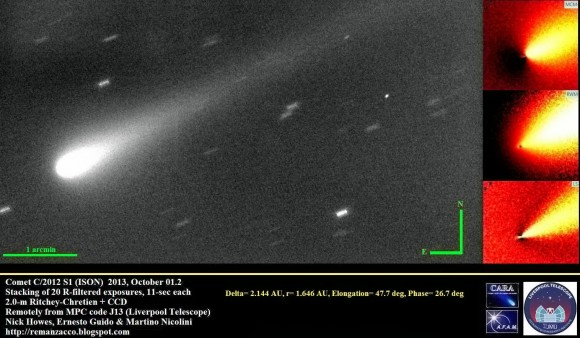Yesterday, October 1st, the highly publicized Comet ISON passed its closet point to Mars. ISON flew by mars at 10.5 million kilometers, or about 6.5 million miles for you non-science people. An image taken from the 2 meter Liverpool telescope in the United Kingdom captured the comet just before its closest pass by Mars. Here is the image:

Source: Universe Today
The image taken from the Liverpool telescope in the United Kingdom is a composite of 20 different exposures, each an 11 second duration. According to scientists Ernesto Guido, Nick Howes and a new team member named Martino Nicolin, “[the image shows a] well developed coma and tail measuring at least 3 arc minutes”.

Comet ISON imaged from Liverpool. Mars is in the bottom right. Source: Universe Today
Above is another image taken from Wesminster, Maryland. This image is a composite of 44 30-second exposures, and shows the comet in the top left with Mars appearing in the bottom right. This image shows the distance between the closest pass of ISON. According to the photographers, ISON was not visible with the telescope’s eyepiece, and stacking the images was required to view the comet.
Nick Howes explains that there was an internal debate regarding whether or not the comet had additional jet streams coming off it. Tests run by the team showed that these were maybe spontaneous events, but one test showed that the additional jet stream might be a constant feature of the comet. Later comparisons of data between Liverpool and The Planetary Science Institute confirmed that this feature is a in fact constant. Additionally, it can be seen in previous ISON observations, including those from Hubble.
ISON will reach its perihelion, the closest point to the sun, on November 28. If it survives, it will be at its closest point to Earth on December 26. It will be some 64 million miles above the Earth’s surface. Some might even call it a Christmas miracle.
Despite the government shutdown, observations from the Mars rover Curiosity are still ongoing because the rover is operated from the Jet Propulsion Laboratory, and will continue to operate unless previous NASA funding runs out.
